
 by Steven D. Johnson
by Steven D. Johnson
Racine, Wisconsin
This month:
•
Sharpening – The Elusive "Perfect Edge"
•
Power Sharpening On The Tormek – How It Works, Subtleties & Nuances, Cost Justification
•
More Most Frequently Asked Questions (MFAQs)
Sharpening – The Elusive "Perfect Edge"
Click on any picture to see a larger version.
What Is Sharp?
The number of woodworkers that have told me they can't get their tools sharp enough is staggering. My response is always the same: "How do you know?"
There is currently no definitive measurement for the sharpness of plane irons, chisels, or other hand-powered woodworking tools. Efforts have been made to develop affordable and comparable objective tests but none have caught on. Most are limited in scope or applicability, are of questionable veracity, are not really applicable to our uses in woodworking, or are so subjective as to be essentially worthless.
One can cut a piece of paper, shave the hair on their arms, or inspect the edge with a magnifier... these are merely subjective demonstrations. One attempt at an objective test methodology measures the force required to cut through a thread. Interesting, but meaningless. A blade might be ridiculously sharp at the point at which it intersects the thread, and a mere fraction of a millimeter away, the blade could have a "dull" section, rendering the blade less than ideal in actual application. To get an exaggerated visual of this, think of a chip in a plane blade leaving an "un-planed" strip along your wood. A few dull micro-sections would make a blade feel "draggy." In other words, edge inconsistency is not measured, even though it has a profound impact on tool performance.
Unfortunately we must acknowledge that there is currently no definitive measurement for sharpness, nor is there a definitive measurement for the consistency of sharpness along the length of a blade edge or, importantly, the durability of the edge.
Compound this absence of a coherent and objective measurement of sharpness and consistency with the limitless ways that tools can be set up and used, and we wind up with a simple truism... What is sharp to you may not be sharp to me, and what is sharp to me may not be sharp to someone at a higher level of expertise or discrimination.
If it were possible to sharpen two plane irons to absolute identical sharpness (and it is not), even those irons would perform differently in different planes. I could go on and on, but you see the difficulty. A definitive discussion of sharpening and an objective definition of "sharp" simply are not possible at the current time. But that could change.
Sharpness Testing In Industry
For reasons ranging from productivity, manufacturing consistency and quality control, worker efficiency, and the mitigation of potential liability lawsuits, a method of measuring and standardizing sharpness is important throughout industry. Sharp knives work better, faster, and with less effort. Sharpening a blade too often increases production costs and necessitates more frequent replacements of the blade. And if a man or woman slicing chicken parts suffers an accidental cut or a repetitive motion injury linked to the sharpness, or lack thereof, of a blade, the potential exists for litigation.
There are a number of edge test instruments that have been developed. All work around two similar principles:
-
Using a sawing motion a blade cuts through a standardized test media (usually a stack of specially prepared papers) and the force and time required to cut all the way through is recorded or alternatively the depth of cut at a given force and time is measured.
-
Using a straight push, a blade is driven into a standardized test material and the force required to complete the cut is measured.
Both of these tests also measure blade longevity by making repeated cuts and measuring the degradation of the blade over multiple cuts. In other words, as the blade dulls, it takes more force and time to make the same cut. The force and time is plotted on curves to compare blade longevity.
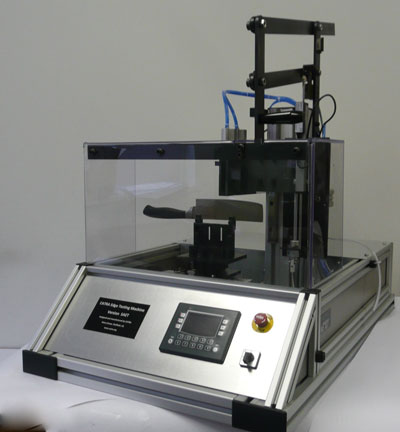
|
Figure 1 - Sharpness and edge testing
machine made by CATRA
|
The Cutlery and Allied Trades Research Association (CATRA) in Sheffield, England is one of the better known organizations involved in the efforts to standardize tests and testing equipment for edge sharpness measurement. Sheffield should ring bells for Americans, since the town is virtually synonymous with fine knives. CATRA provides R&D, product testing, technical consultation, machinery design services, commercial test instruments, and more.
In addition to several edge sharpness testing machines, CATRA supplies a laser goniometer test instrument (a goniometer precisely measures angles) that plots sharpened edge geometry and tip condition, a blade edge profile microscope that can provide visual images as well as computer calculated edge sectional angles, thicknesses, and radii, and highly specialized instruments that measure the effects of wear, heat, corrosion, and more. I couldn't find a better source to discuss blade sharpness.
The International Cutting Test Standard (BS EN ISO 8442-5:2005) was developed and is applicable to hand-powered cutting tools relative to the preparation of food. However, there is no reason the standard couldn't be utilized for woodworking tools. Of the two tests I described above, the straight push-through test would be most applicable, as it would most closely mimic the way chisels and plane irons work… we don't use a sawing motion with those tools.
In the ISO test, sharpness is expressed in units of "N" or Newtons… the force required to push a blade through the test material. A Newton is the force needed to accelerate 1 kilogram of mass at the rate of 1 meter per second squared. For example and comparison purposes, a razor blade would typically test at 0.3 to 0.4N (Newton), a surgical scalpel at 0.4 to 0.6N, a utility knife blade at 1.0 to 1.4N, and a well-honed kitchen knife at 1.8 to 3.0N.
Initially I thought that if a machine could provide consistent comparative edge sharpness data, it would be interesting and fun for a woodworking club or a vendor to acquire such a unit. It would be a huge draw at woodworking shows… "Come test your best-sharpened blade," or "Test your blade sharpness against a pro's!" Unfortunately, my conversation with CATRA quickly nipped that concept in the bud, since their sharpness and durability testing machine costs $35,000 and then there are test materials (consumables) to buy. I doubt many woodworking clubs are well heeled enough to invest in the concept. Still, there is a definite need for a standard and a testing methodology in woodworking.
According to CATRA, Stanley Tools owns one of their testing machines, as does Spyderco, Buck Knives, Fiskars, Inc., Benchmade, Leatherman, W R Case and a few other knife manufacturers in the U.S. Stanley is likely using the machine to test their utility knife blades, but perhaps they might be persuaded to provide a loaner for the next big woodworking show. Personally, I would like to know how my blades stack up, not only in Newtons, but also against other woodworkers, because, as we have learned, we just really don't know how sharp our blades are.
Testing the sharpness of an edge is only one part of the body of knowledge we need to amass in order to elevate our conversations about blade sharpness. We need also to learn about the applicability and utility of various blade shapes.
Blade Geometry
The basics are pretty simple. A cutting edge consists of two adjacent surfaces tapering to an edge, and the thinner and more polished that edge becomes the sharper the blade, in theory. But from this basic concept it gets a little more complicated.
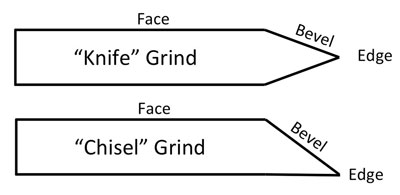
|
Figure 2 - Double bevel (top) and
single bevel (bottom) grinds
|
Double bevels are common on knife blades, axes, and utility cutting blades, and describe a blade in which two surfaces are ground from the initial blade stock thickness to the edge at a prescribed angle. These double bevel edges are often called "knife grinds."
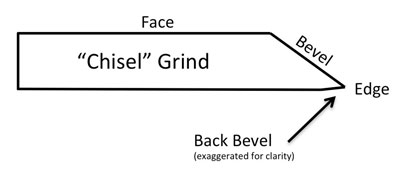
|
Figure 3 - So-called "back bevel" ---
actually a modified double bevel
|
Single bevels are blades that are ground on only one face, creating a single angle that tapers to an edge adjacent to the flat blade stock. This is what we typically see on plane irons and chisels… in fact these types of blade geometries are often described as "chisel grinds." A chisel ground blade can also incorporate a slight "back bevel" which essentially makes the blade a type of modified double bevel (see images).
Whether the blade is a double bevel or a single bevel, there are many sub-profiles. A "flat grind" is just that… the bevel is (or should be) perfectly flat along its width and length. Some woodworkers utilize a "hollow ground" bevel… this is essentially a bevel with a concave face. There are also numerous "convex grinds" and so-called "gothic arch" bevels. These more complex geometries may be formed on one or both sides of a double-beveled edge or only on the bevel surface of a single-bevel cutting edge.

|
|
Figure 4 - A single bevel blade with a "hollow grind"
|
Which blade geometry is best? Like edge sharpness testing, in woodworking there is little objective measurement and a lot of subjective opinion presently. Many woodworkers like a hollow-ground bevel because this geometry is perceived to be conducive to hand honing. It is easy to find and hold the correct blade angle when free-hand honing, and some contend that since there is less metal in contact with the honing stone, it is easier and faster (I will refute that point in the next section). Some woodworkers feel that a hollow-ground edge is inherently weaker.
When we contemplate the action of a plane blade in a hand plane, or a chisel in a cut, we must also consider the action of the "chip" or "curl" of wood as it is cut, and determine whether a flat grind, hollow grind or a convex grind is the best geometry. Would the optimal grind shape differ if it is installed in a bevel-up or a bevel-down style plane? It seems likely that it would, but would the difference be noticeable in use? Would the choice of blade geometry impact the surface quality of the planed wood? Is there an overall "best" geometry for woodworking? Which, of course, leads us to the logical question, is there a "best" way to sharpen tools?
Until we have objective testing we might never really know. Woodworkers will continue to be baffled, bewildered, and frustrated by sharpening, occasionally wowed by inane demonstrations, and will continue to argue the relative merits of bevel-up, bevel-down, hollow-grind, flat-grind, back-bevels, and more. It's just what we do in a vacuum of definitive information… but it is fun!
Hollow Grind… Is It The Hollow Grail Of Sharpening?
Anything shaped and sharpened on the outside surface of any kind of a wheel produces a so-called hollow grind. The only way to achieve a flat grind is on a flat surface. If you have ever shaped or sharpened on a bench grinder, you created a hollow grind.
The bigger the circumference of the wheel, the more shallow the hollow grind. The big ball world we live on looks flat and for thousands of years we tiny human inhabitants believed it was (some still do). But we know it is really round. If we gain perspective, say on top of a mountain or in an airplane, we can see the earth's curvature along the horizon line. The bigger the circle, the flatter the surface appears up close.
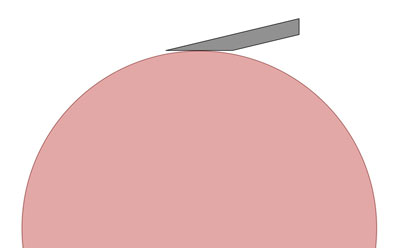
|
Figure 5 - How "hollow grind" occurs on a
grinding wheel
|
If a woodworker grinds on a six-inch grinding wheel, the concave curve produced on the bevel will be more pronounced than the concave curve produced by an eight-inch wheel or even a ten-inch wheel. If I had a sharpening wheel fifty feet in diameter, I could produce a bevel that would appear, for all intents and purposes, to be perfectly flat. Only a delicate and precise measuring instrument could provide the perspective necessary to prove the bevel was concave… but it would be. You cannot shape, sharpen, or hone a flat bevel except on a flat surface. Period.
Many woodworkers swear by hollow grinds. When asked why they prefer the concave bevel, they usually give one or two of three common reasons: (1) Final sharpening and honing is performed on a smaller section of the blade so it removes less metal, (2) because less metal is in contact with the stone (or sandpaper) it is easier or takes less time to hone, or (3) they claim to get better blade performance (a sharper edge).

|
Figure 6 - Honing on a flat stone or sandpaper
creates small "flats" on either side of the
hollow grind
|
Let's examine these one by one. First, the idea of "removing less metal" is spurious. The act of creating the concave "hollow grind" bevel has already removed additional metal in making the concave section, and each successive honing session will eventually bring the smaller "flats" created on the bevel to level, and there will be no hollow grind. The net result is that the same amount of metal eventually gets removed.
Second, the idea of less metal in contact with the stone or sandpaper making it easier to sharpen is ridiculous. The amount of pressure applied and the caloric burn during the stroking of a blade across a stone is minuscule… I doubt the difference in pressure or effort expended could even be measured. Woodworkers
perceive
the sharpening to be easier for a different reason. A hollow ground blade is easier to "hand" hold at the proper honing angle, making it easier to keep the blade in constant perfect angular alignment with the stone.
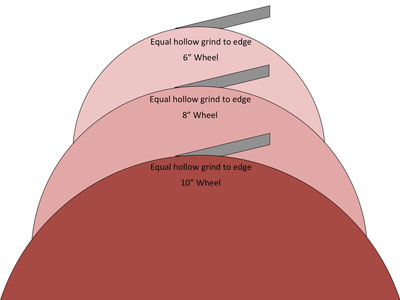
|
Figure 7 - A larger wheel will produce a less
pronounced hollow grind
|
Third, as far as producing a better edge, that is largely a subjective rationale.
As a fourth reason, sometimes overlooked, there may be some reduced wear on the chosen waterstone, since initially only the small "flats" on the bevel are honed.
Are there any disadvantages to a hollow grind? Again, in the absence of any real definitive information relative to the cutting action in wood, the only potential drawback that woodworkers typically discuss is that a concave bevel might weaken the blade.
While I suppose that is possible, it would seem only to come into play with a blade that is struck, or strikes, with considerable force. In some fifty years of woodworking, I have seen some pretty badly mangled blades, but I have never seen a blade broken parallel to its edge, either hollow ground or not. Perhaps if the "flat" produced by honing is microscopically thin there could be weakening that causes a slight bending of the steel, but again, I have never seen it.
Personally, and this is also obviously subjective, a mortising chisel with a hollow grind does not seem to work as well for me as a flatly ground bevel. I can discern no difference when using a chisel for any of its other myriad uses, and can tell no difference in use between a hollow ground and flat ground bevel in hand planes.
So with only the slight advantage of easier hand-honing, and no real disadvantages, the use of a hollow grind is purely a matter of personal preference, or… and this is the big point here… a matter of expedience. Why expedience? Because a lot of woodworkers find it easier and less time consuming to perform edge shaping and initial sharpening on a powered abrasive wheel. Since that wheel will naturally produce a hollow grind, we might as well be proponents.
(Page 1 of 3)
1
2
3
Next Page
Return to
Wood News
front page

